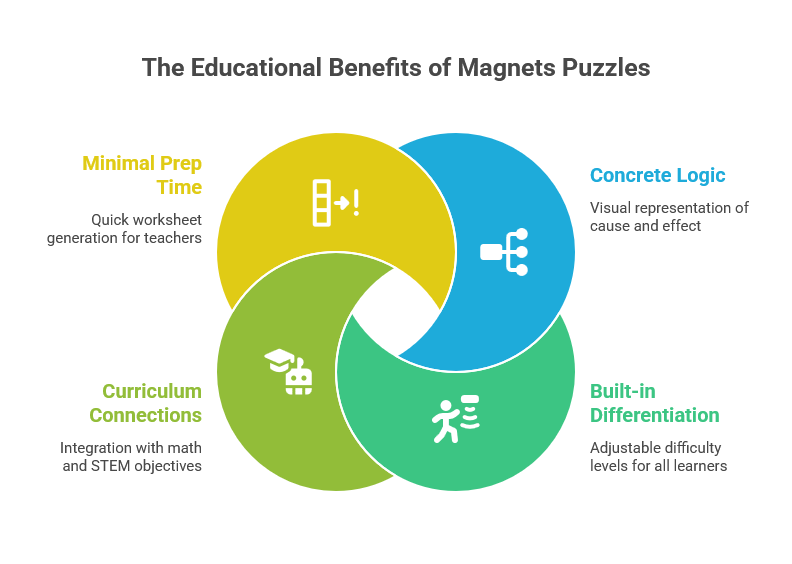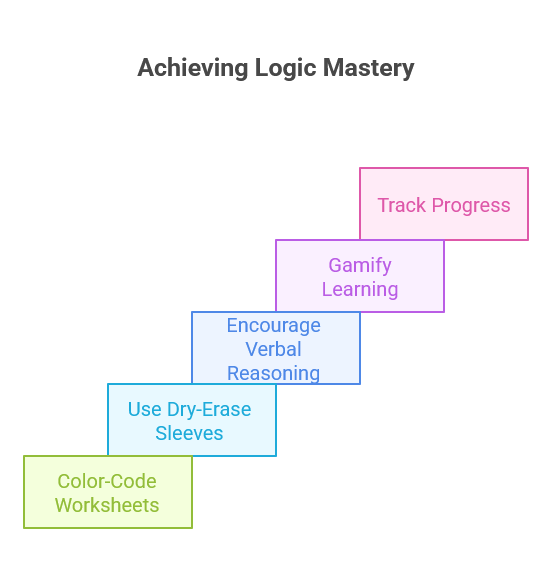Magnets Puzzles for Education: Worksheets & Classroom Activities
Bringing Logic into the Classroom
Logic puzzles aren’t just time-fillers — they’re active workouts for the brain. They nurture critical thinking, focus, and perseverance, all while giving students a sense of accomplishment when they see patterns come together.
Among the many puzzle types available, Magnets puzzles stand out for educators because they combine structure, creativity, and adaptability. The same simple rule-set can challenge second-graders or stretch gifted middle-schoolers — you only adjust grid size and clue complexity.
What Makes Magnets Puzzles Ideal for Teaching

1. Concrete logic you can see
Students physically mark or color cells as “+” or “–”, or use themed icons (lion = +, elephant = –). They see cause and effect: “If this is +, that can’t be.” This bridges the gap between tangible action and abstract reasoning.
2. Built-in differentiation
One puzzle type, many levels. Start with 4×4 or 6×6 grids for beginners; move to 8×8 or 10×10 for advanced thinkers. Everyone works on the same concept at their own pace.
3. Curriculum connections
Magnets puzzles fit beautifully inside math and STEM objectives:
- Counting and comparison (matching row/column totals)
- Spatial reasoning (domino regions and adjacency)
- Deductive reasoning (“if-then” logic)
- Cooperative problem-solving (pair or group challenges)
4. Minimal prep time
Once you have a generator, producing new worksheets takes minutes, freeing teachers to focus on delivery rather than design.
Ways to Use Magnets Puzzles in Class
Morning Starters
Five-minute logic warm-ups set a productive tone. Project a puzzle on the board; students mark answers in notebooks or mini whiteboards.
Result: quiet engagement right from the bell.
Math Centers
Create rotating stations with laminated 6×6 puzzles. Students work in pairs, checking each other’s logic. When they finish, they swap stations for a new grid.
Team Challenges
Print large 10×10 grids on A3 paper. Give each group colored markers and set a timer. Award points for correct grids and teamwork — every deduction must be explained aloud.
Thematic Tie-Ins
- Physics: Demonstrate polarity and attraction/repulsion through puzzle play.
- Holidays: Replace poles with icons — pumpkins and ghosts in October, hearts and envelopes in February.
- Language Arts: After solving, students write a short explanation of their reasoning (“First I looked at the row with 0 +, then …”). It turns logic into a writing exercise.
How to Create Worksheets the Fast Way
Traditionally, logic-puzzle prep meant hours of manual grid design and checking solutions.
Now, with Puzzle Maker Pro – Magnet Logic, educators can:

- Select grid size & difficulty — 4×4 for younger students, 8×8 for enrichment.
- Choose a theme — colors, animals, holidays, or custom icons.
- Generate puzzles automatically with balanced clues and single solutions.
- Preview & print ready-made PDFs for class or upload to learning platforms.
Need ten unique versions for a logic-club competition? Click “Generate x 10” and export instantly.
Each worksheet comes with:
- Puzzle grid
- Clues (top/bottom/side)
- Optional solution key
- Title area for “Name / Date / Score”
Assessment & Extension Ideas
Reflective journaling
After completing a puzzle, ask: “Which clue helped you the most?” or “What did you do when you got stuck?”
This metacognition exercise turns logic into self-awareness.
Error analysis
Give students a puzzle that includes one intentional mistake in the clues. Their task: find and justify the inconsistency.
Create-Your-Own Puzzle
Once they grasp the rules, students design mini-puzzles (3×4 grids). They must ensure clues produce exactly one solution — an authentic test of logical understanding.
Cross-subject connections
- Art: Students design themed icons for +/–.
- Technology: Export puzzles digitally, solve on tablets with stylus input.
- Language: Vocabulary tie-ins (“positive/negative,” “north/south,” “attract/repel”).
Practical Tips for Classroom Management

- Color-code levels. Green worksheets for easy, blue for medium, red for challenge.
- Use dry-erase sleeves. Saves paper and enables repeat practice.
- Encourage verbal reasoning. Have students explain aloud why a region must be neutral.
- Gamify. Award “Logic Master” badges for completed sets.
- Track progress. Maintain a simple chart: each puzzle = 1 point. Collect enough points = class reward.
For Educators Who Sell or Share Materials
If you’re on platforms like Teachers Pay Teachers, Etsy, or your own website, Magnets puzzles translate perfectly into downloadable packs.
Ideas:
- “Logic Warm-Up Pack 1 – Animal Edition”
- “Holiday Magnets Bundle – 15 Printable Logic Puzzles”
- “STEM Logic Challenge Grades 4–6”
Each pack can include puzzles, answer keys, and instructions. Low production cost + evergreen appeal = sustainable income stream.
Why Students Benefit
Magnets puzzles reward process over guessing. Each move follows logically from clues, which encourages persistence and accuracy.
They also build confidence: even struggling math learners can experience success because the feedback is immediate — the grid either fits or it doesn’t.
Teachers report calmer classrooms during puzzle time; students focus deeply, often asking for “one more.”
Conclusion
Magnets puzzles bring structured fun to any classroom. They teach logical thinking, support cross-curricular skills, and are endlessly reusable.
Whether you’re creating resources for your own students or selling professional worksheet bundles, this puzzle type offers a powerful combination of pedagogical value and practical efficiency.
Generate your first classroom pack with the Magnets Puzzles Generator, print a set for tomorrow’s lesson, and watch your students fall in love with logic.
